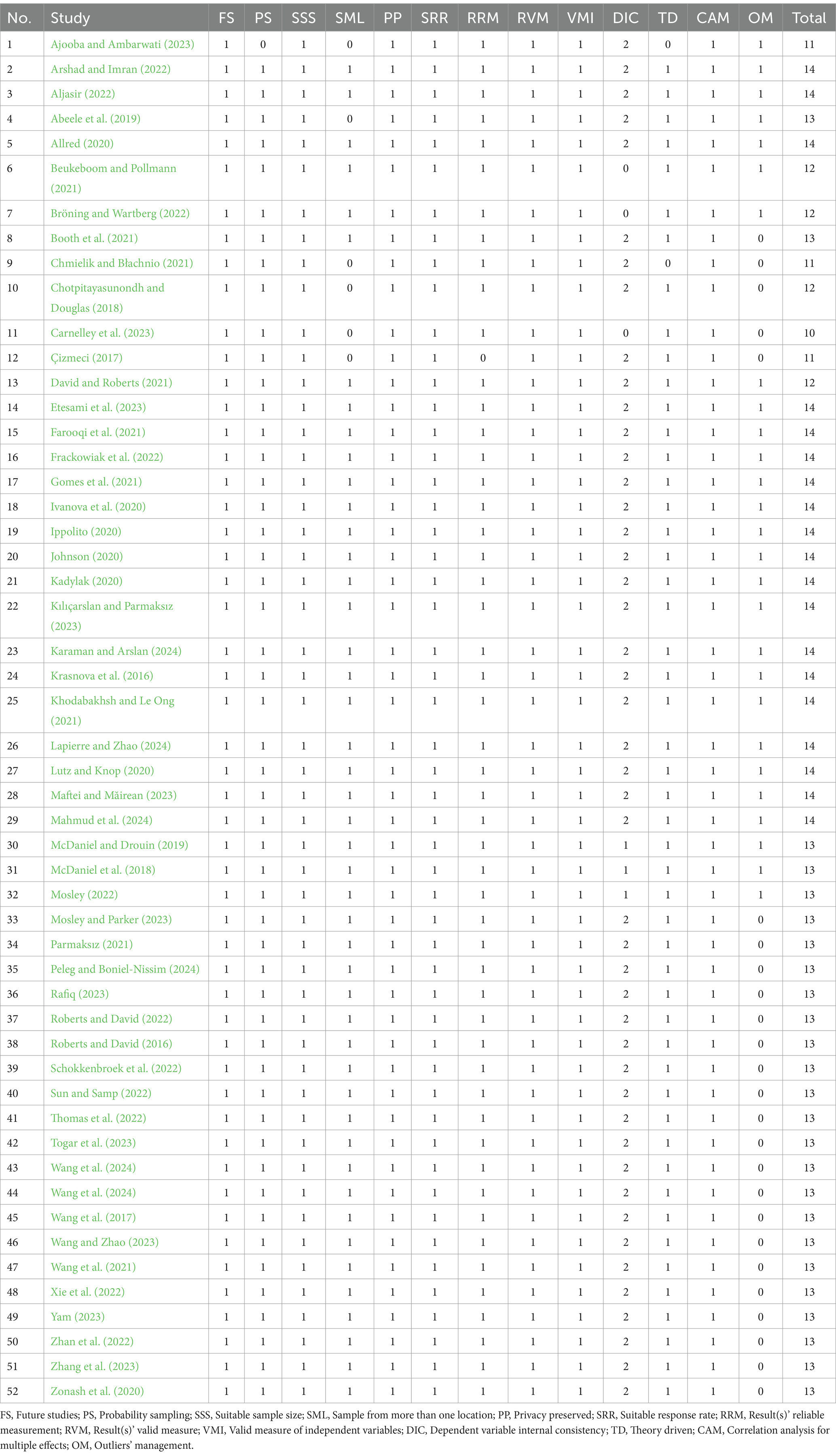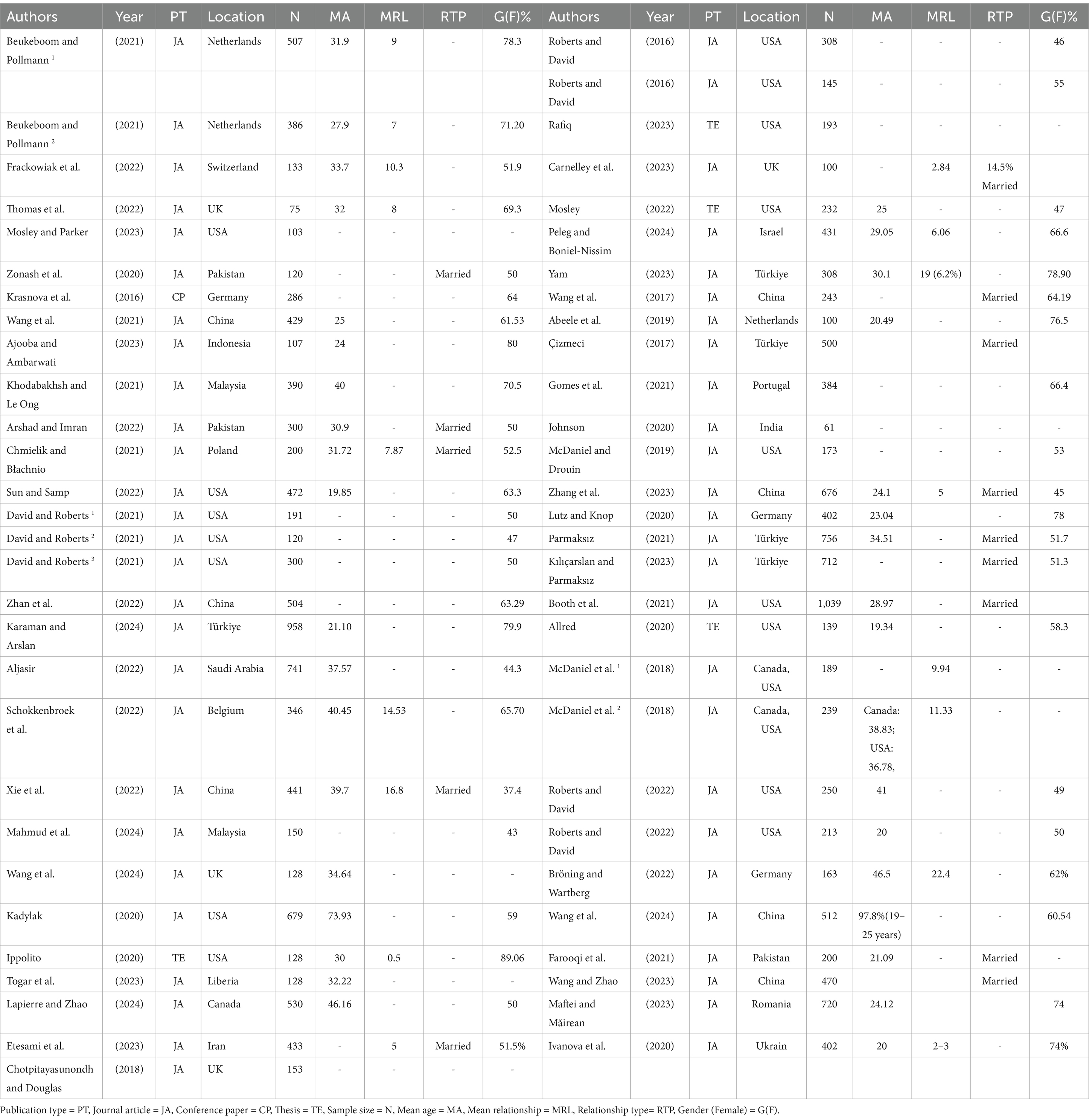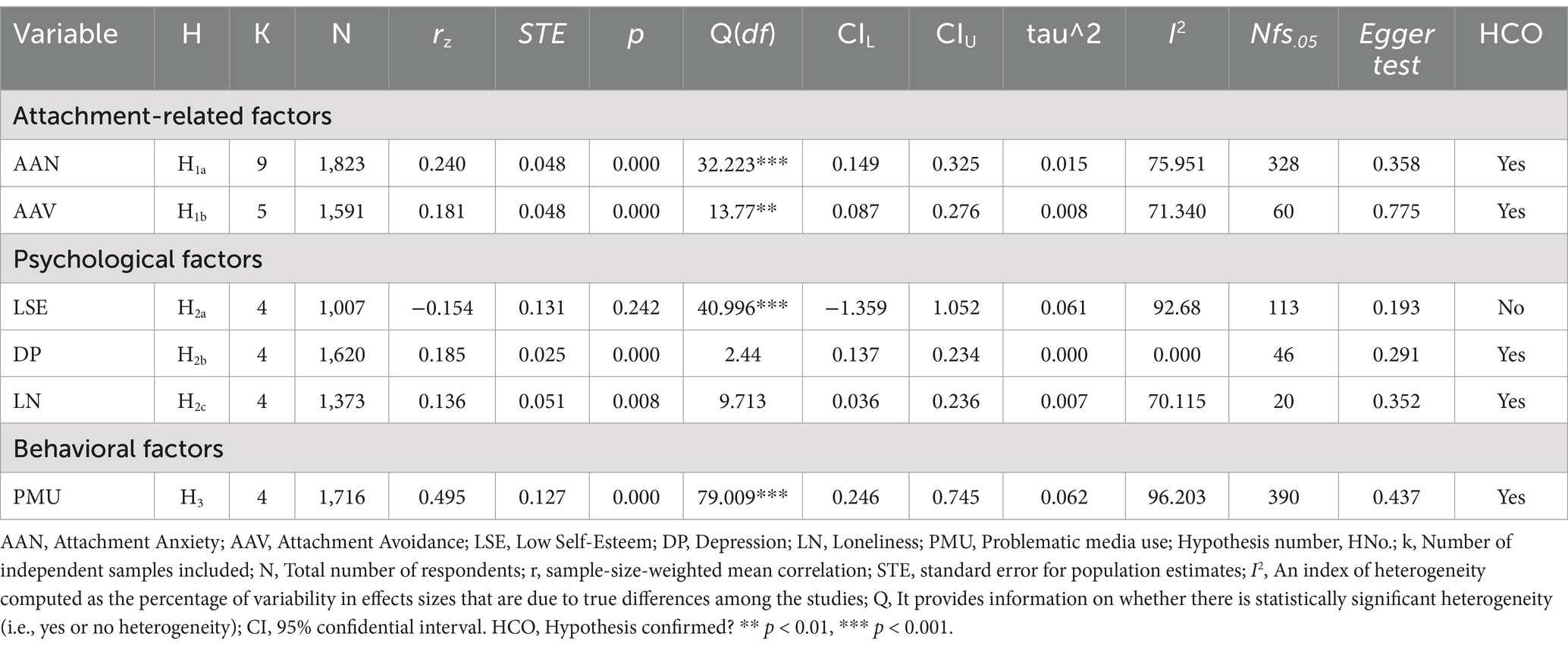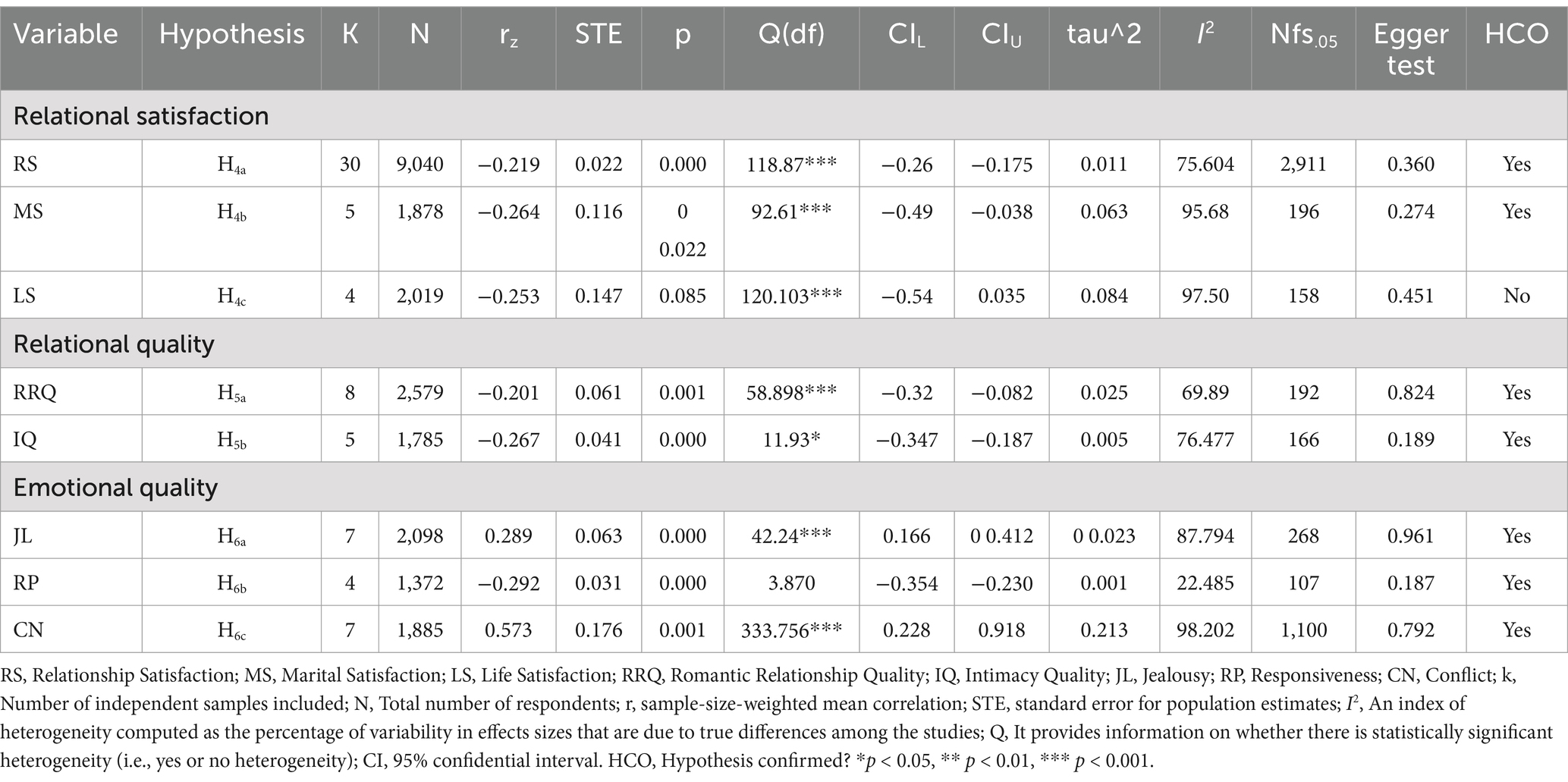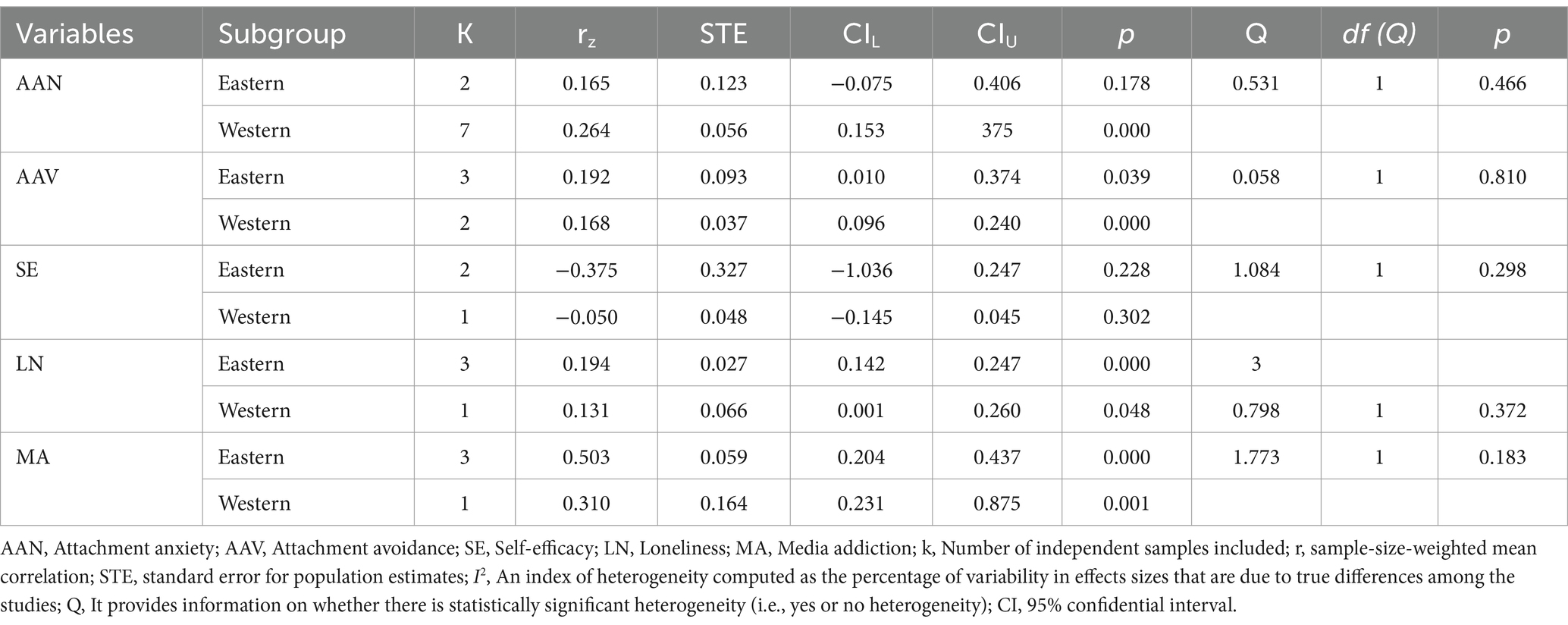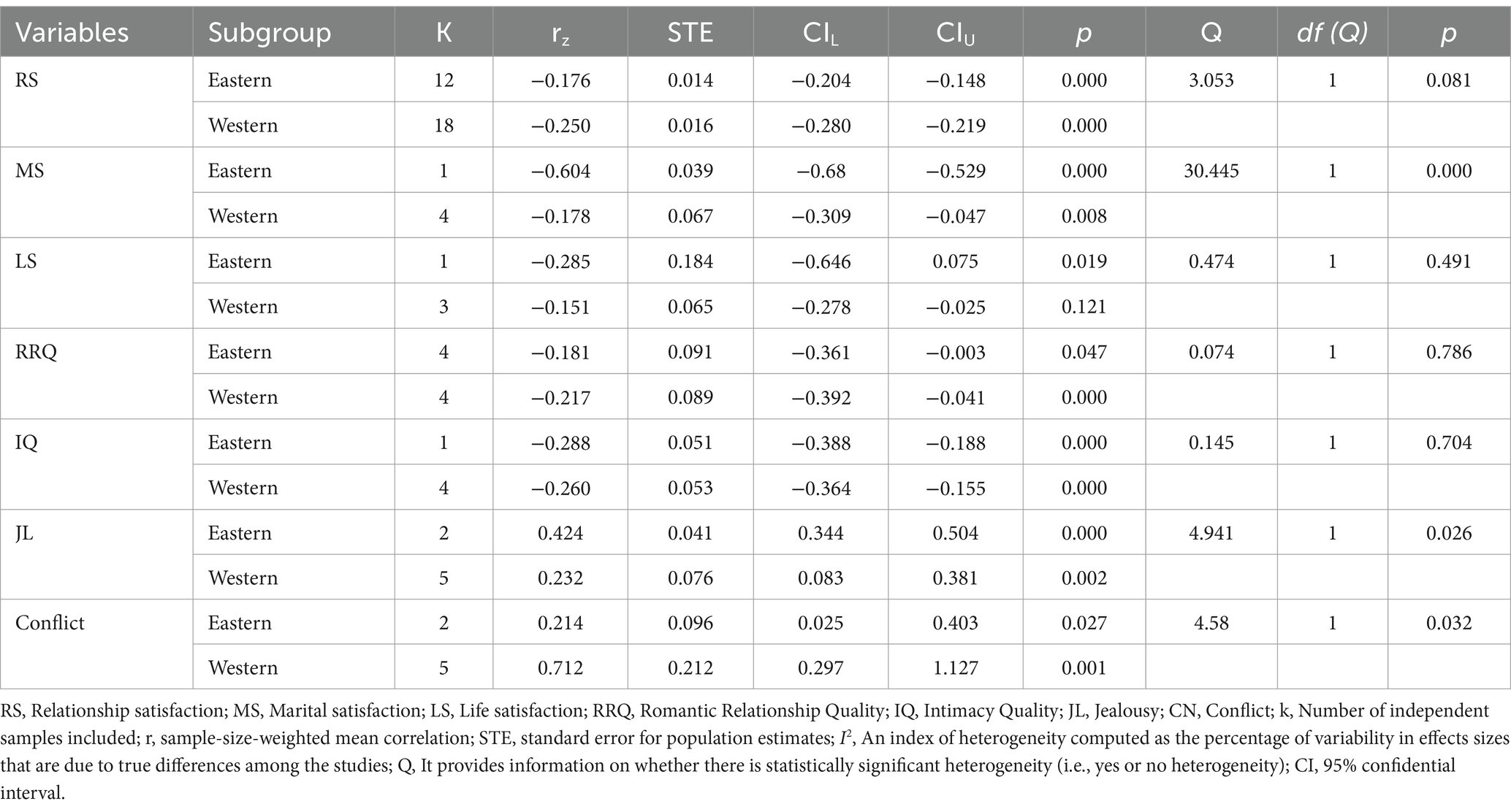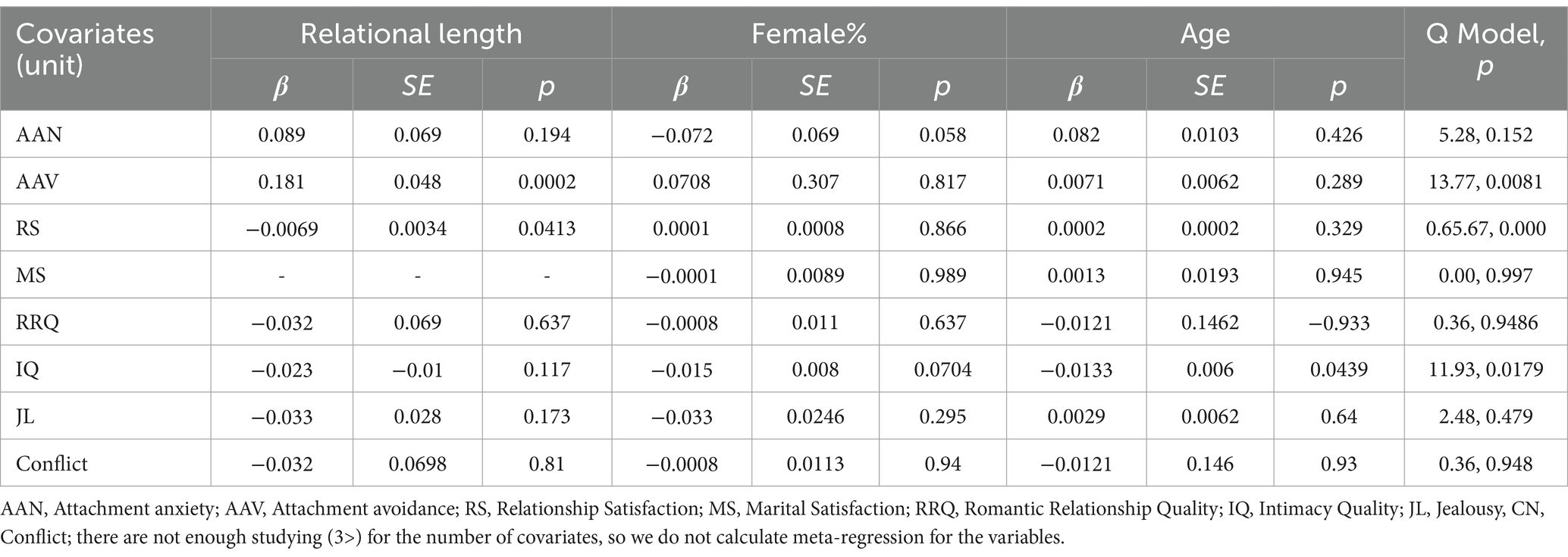- 1Department of Educational Studies, Yuncheng University, Yuncheng, Shanxi, China
- 2Preschool Education Research Center, Shanxi, China
- 3Women and Family Studies Research Center, University of Religions and Denominations, Qom, Iran
- 4Department of Social Science and Development Studies, Women Research Center, Alzahra University, Tehran, Iran
- 5Faculty of Educational Studies, Universiti Putra Malaysia, Serdang, Malaysia
Partner phubbing (Pphubbing)—the act of ignoring one’s romantic partner in favor of a smartphone or digital device—has become a widespread behavior, with detrimental effects on romantic relationships. This meta-analytic study synthesizes data from 52 studies (58 samples, n = 19,698) to examine both the antecedents and consequences of Pphubbing, providing a comprehensive understanding of its impact on relational dynamics and emotional well-being. The findings indicate that antecedents such as attachment anxiety, attachment avoidance, depression, and loneliness are significantly correlated with Pphubbing, with media addiction showing the strongest association (rZ = 0.492). In contrast, self-esteem was not found to be a significant predictor of Pphubbing. Regarding the consequences, Pphubbing negatively affects several relational outcomes, including relationship satisfaction, marital satisfaction, romantic relationship quality, intimacy, responsiveness, and overall emotional closeness. It also contributes to increased conflict and heightened feelings of jealousy within relationships. These findings underscore the far-reaching implications of Pphubbing on both individual and relational well-being. We encourage future research to explore additional social, contextual, and psychological factors that may influence phubbing behaviors, and to investigate diverse types of digital interactions that may contribute to relational disruption in different cultural and situational contexts.
1 Introduction
In today’s digital age, smartphones have become indispensable tools in romantic relationships, enabling partners to stay connected, bridge long-distance gaps, and foster emotional closeness (Gomes et al., 2021). Research indicates that technology-mediated interactions, such as daily texting, can enhance relationship commitment, satisfaction, and communication (Aljasir, 2022). However, excessive smartphone use can also become a source of disruption, negatively impacting relationships by reducing quality time, increasing conflict, and leading to feelings of emotional neglect and decreased intimacy (Al-Saggaf, 2022; Arshad and Imran, 2022). This phenomenon, known as partner phubbing (Pphubbing), occurs when an individual prioritizes smartphone use over their partner during interactions, significantly diminishing relationship satisfaction (Beukeboom and Pollmann, 2021; Roberts and David, 2022).
Pphubbing has become a pervasive issue in modern relationships (Carnelley et al., 2023). Research by Roberts and David (2016) found that nearly half of their participants had experienced being phubbed by their romantic partner. This behavior acts as a social allergen, triggering increasingly negative reactions in the affected partner. Even the mere presence of a smartphone during face-to-face interactions can inhibit feelings of closeness and interpersonal trust, reducing empathy and understanding between partners (Roberts and David, 2016; Zhan et al., 2022). As a result, Pphubbing not only diminishes relationship quality but can also foster emotional disconnect, making it a serious concern in maintaining healthy romantic connections.
Several studies have examined both the antecedents and consequences of Pphubbing in relationships. Antecedents such as insecure attachment (Mosley, 2022), self-esteem (Wang et al., 2021), and jealousy (Arshad and Imran, 2022) have been linked to an increased likelihood of engaging in or perceiving Pphubbing behavior. The consequences of Pphubbing are typically associated with reduced relationship satisfaction, diminished relationship quality, and poorer emotional well-being (Chmielik and Błachnio, 2021), though most studies demonstrate correlational rather than causal relationships due to predominant cross-sectional designs.
However, research findings on Pphubbing show three specific inconsistencies: (1) variable effects (e.g., attachment anxiety showing stronger effects than avoidance in some studies but not others), (2) population differences (Western samples reporting more conflict while Eastern samples show greater marital satisfaction impacts), and (3) methodological variation (effect sizes ranging from 0.12 to 0.31 across study designs). These inconsistencies highlight the need for more comprehensive meta-analyses to clarify Pphubbing’s complex dynamics in romantic relationships. Given these gaps, a meta-analytic approach can statistically combine results to uncover patterns (Tamilmani et al., 2019). While prior meta-analyses examined Pphubbing in non-romantic contexts (e.g., parental phubbing; Lin et al., 2024) or smartphone addiction (Ansari et al., 2024), none analyzed romantic relationship outcomes specifically.
The current study aims to synthesize findings on the antecedents and consequences of Pphubbing in romantic relationships, with particular attention to potential cultural moderators. Specifically, it examines how cultural context influences (1) the strength of relationships between key predictors (e.g., attachment styles, media addiction) and Pphubbing, and (2) the magnitude of Pphubbing’s effects on relationship outcomes. By organizing these findings into an integrated framework, the study advances theoretical understanding while providing practical guidance for addressing Pphubbing across different cultural settings.
2 Literature review
Pphubbing, a combination of “partner” and “phubbing” (phone snubbing), describes the act of ignoring a romantic partner in favor of using a smartphone or digital device (Komnik, 2024; Lutz and Knop, 2020). This behavior has both behavioral and psychological dimensions, involving not just the physical act of engaging with a device but also the emotional consequences for the partner who feels neglected. Conceptually, Pphubbing disrupts face-to-face communication and can be perceived as a form of micro-betrayal, eroding trust and emotional intimacy. Over time, this can significantly diminish relationship quality and stability, as it is often associated with attachment issues, reduced relationship satisfaction, and increased dependence on technology.
To effectively measure Pphubbing, researchers have developed comprehensive scales that capture its frequency, context, and impact on relationships. One key tool is the Partner Phubbing Scale (PPS) created by Roberts and David (2016), which consists of nine items that assess how often individuals perceive being ignored by their partners due to device use, such as “My partner glances at his/her cell phone when talking to me.” Participants rate each item on a five-point Likert scale, and higher scores indicate higher levels of perceived Pphubbing. This scale has shown strong reliability and validity, with Cronbach’s α scores ranging from 0.80 to 0.89 across various studies and languages.
2.1 Antecedents of Pphubbing
In this study, a multi-theoretical framework was adopted, integrating Attachment Theory (Bowlby, 1975), Social Exchange Theory (Homans, 1958), a cognitive approach inspired by Cognitive Behavioral Theory (Beck, 1993), and Media Dependency Theory (MDT; Ball-Rokeach and DeFleur, 1976) to provide a comprehensive explanation of the antecedents of Pphubbing, while emphasizing the distinct role each theory plays in shaping this behavior. The framework focuses specifically on attachment anxiety and avoidance as key relational antecedents.
Attachment theory suggests that early life relationships shape adult attachment styles, which in turn affect how individuals engage in and respond to Pphubbing (Bröning and Wartberg, 2022). Those with high attachment anxiety tend to fear rejection and abandonment, making them particularly sensitive to perceived relationship threats such as Pphubbing (Bröning and Wartberg, 2022; Roberts and David, 2016). On the other hand, individuals with high attachment avoidance, who value independence and are uncomfortable with intimacy, may use Pphubbing as a way to create emotional distance or cope with neglect (Sun and Miller, 2023). Attachment theory thus highlights how emotional insecurity within relationships contributes to Pphubbing behavior, positioning it as a relational coping strategy.
SET complements this perspective by shifting the focus to the perceived costs and benefits of interpersonal relationships. SET posits that relationships are maintained through a cost–benefit analysis, where individuals seek to maximize rewards like emotional connection while minimizing costs such as neglect or rejection. In this context, low self-esteem, depression, and loneliness can be seen as psychological “costs” that make individuals more susceptible to the negative effects of Pphubbing (Chmielik and Błachnio, 2021). Individuals with low self-esteem may interpret Pphubbing as a sign of rejection, intensifying their emotional distress, while loneliness and depression exacerbate this relational strain as Pphubbing worsens feelings of isolation and detachment. These psychological factors were chosen due to their well-documented associations with emotional distress in relationships, making them highly relevant antecedents of Pphubbing.
The cognitive approach, drawing from Cognitive Behavioral Theory, emphasizes the role of maladaptive cognitions in shaping emotional and behavioral responses to Pphubbing. This perspective focuses on how negative thought patterns, such as “My partner’s phubbing means I’m unlovable,” amplify emotional distress. These cognitive distortions mediate the relationship between psychological vulnerabilities (e.g., low self-esteem, depression) and heightened sensitivity to Pphubbing, offering a micro-level complement to SET’s macro-level cost–benefit analysis. Unlike SET, which focuses on external relational dynamics, the cognitive approach highlights internal cognitive processes, such as negative automatic thoughts and dysfunctional beliefs about self-worth, rejection, or abandonment (Beck, 1993). For example, individuals prone to distorted cognitive patterns may perceive Pphubbing as intentional or threatening, reinforcing feelings of worthlessness or social exclusion. This cognitive lens provides a nuanced understanding of individual vulnerabilities to Pphubbing, distinguishing it from the interactional focus of SET.
Finally, MDT complements these psychological antecedents by explaining the compulsive nature of Pphubbing, as individuals become increasingly reliant on smartphones to fulfill personal needs for social connection, entertainment, or information (Ball-Rokeach and DeFleur, 1976). As smartphone dependency grows, individuals may engage in Pphubbing more frequently, leading to relational disruptions (Karaman and Arslan, 2024). This theory was chosen because it offers a comprehensive explanation of the underlying mechanisms driving problematic media use in relational contexts. Research supports a strong correlation between problematic media use and Pphubbing, with those heavily engaged in digital environments more likely to engage in Pphubbing (Harmon and Duffy, 2022).
2.2 Consequences of Pphubbing
In this study, Social Exchange Theory (SET), Attachment Theory, and Cognitive Dissonance Theory (CDT; Festinger, 1957) were employed to examine the relational and emotional consequences of Pphubbing in a theoretically integrated manner. Drawing from these frameworks, Pphubbing is shown to negatively impact individuals’ experiences of relational well-being (e.g., overall relationship quality, intimacy, and satisfaction) and emotional well-being (e.g., jealousy, insecurity, conflict, and diminished partner responsiveness) (Thomas et al., 2022).
Relational consequences can be best understood through the lens of SET, which emphasizes that individuals assess their relationships based on a cost–benefit analysis. When one partner engages in Pphubbing, the other often feels ignored or undervalued, leading to reduced emotional and relational “rewards” such as attention, responsiveness, and intimacy, and increased “costs” like neglect and frustration (David and Roberts, 2021). This imbalance adversely impacts relationship satisfaction, intimacy quality, and overall relational harmony. Rather than separating constructs like marital satisfaction, life satisfaction, and relationship satisfaction, this study conceptualizes them under the broader construct of relational satisfaction to reduce redundancy and better align with theoretical models (Roberts and David, 2016; Wang and Zhao, 2023; Yam, 2023). Thus, Pphubbing disrupts relational balance, decreasing the overall satisfaction derived from romantic interactions.
Emotional consequences, including jealousy, insecurity, and emotional disconnection, are effectively explained by Attachment Theory. Pphubbing threatens the sense of emotional security and trust within a relationship, particularly among individuals with anxious or avoidant attachment styles (Wang et al., 2024). The experience of being phubbed may elicit emotional rejection, activating attachment-related fears and increasing feelings of jealousy and vulnerability. Moreover, intimacy quality, a critical component of romantic relationships, is eroded as digital distractions interfere with meaningful connection and attentiveness. Frequent interruptions due to smartphone use diminish emotional closeness and perceived partner availability, further reducing relational satisfaction (Carnelley et al., 2023; Krasnova et al., 2016).
CDT offers additional insight into the interpersonal conflict and emotional dissonance associated with Pphubbing. According to CDT, individuals experience psychological discomfort when their expectations for emotional availability clash with the reality of digital disengagement. This discrepancy fosters frustration, unmet emotional needs, and interpersonal conflict (Roache, 2018; Zonash et al., 2020). Jealousy often arises when a partner perceives the smartphone as a competing attachment figure, while conflict results from repeated violations of emotional expectations. These emotionally charged interactions create a feedback loop of dissatisfaction, further escalating conflict and detachment.
Another significant consequence is the diminishment of partner responsiveness—the ability to recognize and empathetically respond to a partner’s emotional needs (Itzchakov et al., 2022). Pphubbing diverts attention away from dyadic interactions, impairing the partner’s ability to express support, validation, and empathy. The lack of responsiveness leads to emotional distance, diminished trust, and increased feelings of neglect and resentment. Consequently, emotional intimacy and relationship quality deteriorate.
Finally, research indicates that Pphubbing also intensifies conflict related to technology use, creating a cycle of retaliation and emotional withdrawal. As smartphone-related disagreements emerge, partners may resort to further Pphubbing—either passively as avoidance or actively as retaliation—which exacerbates emotional insecurity and contributes to relational dissatisfaction (David and Roberts, 2021). Based on this literature, a research model has been developed to explore the antecedents and consequences of Pphubbing, as illustrated in Figure 1.
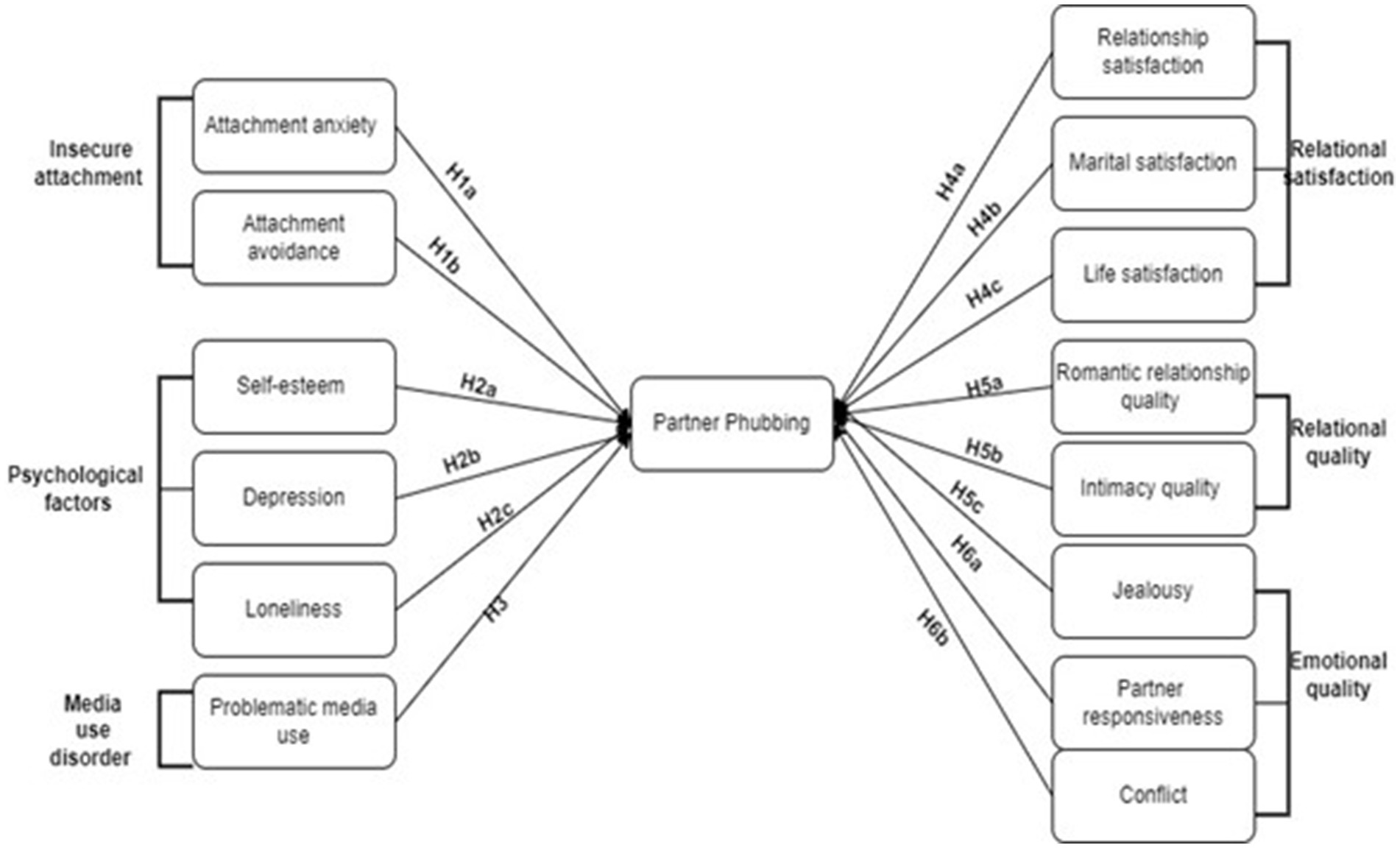
Figure 1. Hypothesized relationships. The model illustrates key predictors (attachment styles, psychological factors, media addiction) and consequences (relational, emotional, and satisfaction outcomes) of Pphubbing, along with hypothesized directional relationships (H1–H6).
2.3 Moderators
Numerous studies have investigated the relationship between Pphubbing and its effects, yet the findings are often inconsistent. These variations may stem from the presence of several moderating factors, such as age, gender, and cultural background, that influence the relationship between Pphubbing and its outcomes. Age serves as a significant moderator, with younger couples, particularly those in the early stages of their relationships, placing greater emphasis on constant communication, thereby being more susceptible to the negative effects of Pphubbing (Chmielik and Błachnio, 2021; Khodabakhsh and Le Ong, 2021). In contrast, older couples, who prioritize quality time and face-to-face interactions, may experience different emotional and relational consequences when Pphubbing occurs.
Gender is another moderating factor, as research shows that women are generally more prone to using social media and engaging in Pphubbing behaviors compared to men (Ivanova et al., 2020; Xie et al., 2022). Women also tend to use mobile phones to alleviate anxiety and maintain social connections, which may exacerbate the impact of Pphubbing on relationship satisfaction. Men, on the other hand, tend to display higher psychological resilience and are less affected by Pphubbing behaviors, reducing their dependence on mobile devices for emotional support.
The length of the relationship further moderates the effects of Pphubbing. Interdependence theory suggests that individuals’ outcomes are influenced by their partners’ behaviors, meaning both positive and negative experiences may be shared in long-term relationships (Rodriguez et al., 2014; Totenhagen et al., 2016). Consequently, in longer-term relationships, one partner’s behaviors, such as Pphubbing, are more likely to affect the other partner’s emotional and relational outcomes (Al-Saggaf and O’Donnell, 2019). This effect may be smaller or even non-existent in shorter-term relationships, making those in longer relationships more vulnerable to relationship dissatisfaction and depression in the face of Pphubbing (Wang et al., 2017).
Cultural background also moderates the relationship between Pphubbing and its effects. In collectivist societies, where interpersonal relationships and social harmony are highly valued, Pphubbing may be more disruptive due to the greater importance placed on maintaining close connections and in-person interactions (Błachnio et al., 2021). The widespread use of mobile devices, particularly among younger generations who have integrated these technologies into their daily lives, has further intensified the prevalence of Pphubbing. Identifying these moderating factors—age, gender, relationship length, and cultural context—provides a deeper understanding of Pphubbing’s varying impacts across different demographic and cultural groups.
3 Research methodology
To test our hypotheses, we conducted a meta-analysis in accordance with PRISMA guidelines and recommendations from prior research (Aytug et al., 2012; Hunter and Schmidt, 2014).
3.1 Identifying sources
The authors used multiple strategies to identify both published and unpublished studies that empirically examined parent phubbing. In August 2024, searches were conducted across databases including Google Scholar, Scopus, EBSCO, DOJA, PsycINFO, ScienceDirect, SpringerLink, JSTOR, Emerald, and ProQuest. The search strategy followed Boolean techniques, pairing keywords such as “partner phubbing” AND “attachment anxiety” OR “avoidance” OR “low self-esteem” OR “depression” OR “loneliness” OR “media addiction” OR “relational satisfaction” OR “marital satisfaction” OR “romantic relationship quality” OR “jealousy” OR “partner responsiveness.” We also contacted authors for unpublished data and conducted an unstructured Google search (Cooper et al., 2019). Finally, reference lists of relevant studies were reviewed to identify additional sources.
3.2 Inclusion criteria
A total of 4,279 sources, including articles, dissertations, theses, and conference proceedings, were initially identified. Each source was reviewed to ensure it met the following criteria: a sample was collected, Pphubbing was measured, and quantitative statistics were reported. After this screening, 191 sources remained. Hundred-thirty-nine sources were excluded due to not measuring the main variables, lack of available outcome data, or unreported statistical results. Two trained researchers independently coded and recorded effect sizes for the desired relationships. Ultimately, 52 datasets met the inclusion criteria for the meta-analysis (Figure 2).
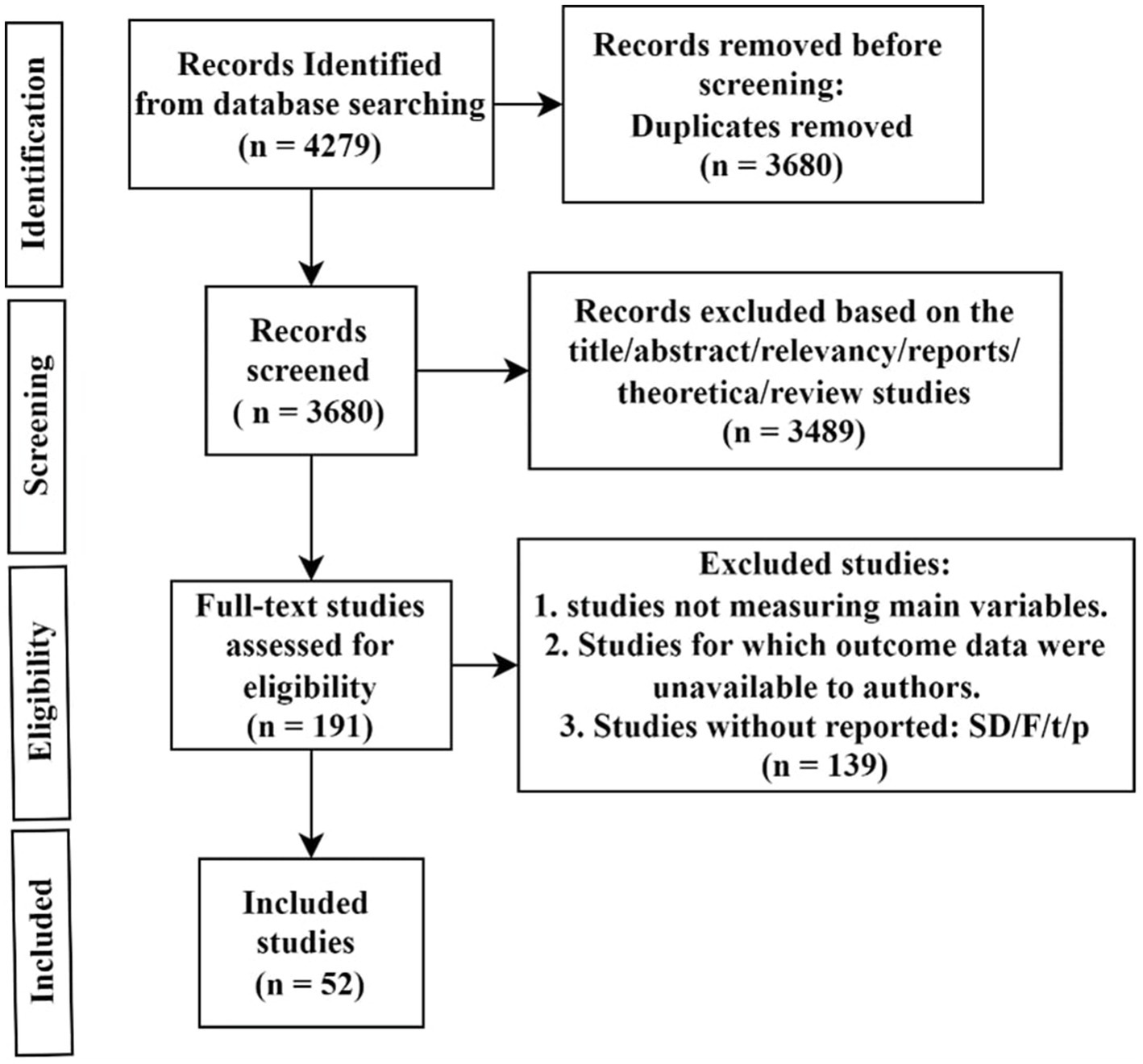
Figure 2. Flow chart for selection of included studies. The PRISMA-style flowchart depicts the study selection process, from initial database searches (n = 4,279) to final inclusion (n = 52), with exclusion criteria clearly specified.
3.3 Data analysis
In this meta-analysis, direct effects refer to the bivariate relationships between Pphubbing and its identified antecedents and consequences—such as attachment anxiety, attachment avoidance, self-esteem, loneliness, depression, relationship satisfaction, life satisfaction, marital satisfaction, jealousy, intimacy quality, conflict, and partner responsiveness. Each of these relationships was treated as a separate direct effect and analyzed independently.
The current authors conducted a separate analysis for each direct effect using Comprehensive Meta-Analysis (CMA) software. Effect sizes, typically correlation coefficients, were weighted by sample size or variance, and a random effects model was employed to calculate meta-analytic estimates, requiring at least three studies per relationship. This threshold was selected to ensure statistical reliability and avoid unstable effect size estimates based on too few data points, which can distort meta-analytic results (Valentine et al., 2010; Steel and Kammeyer-Mueller, 2002). Heterogeneity among studies was assessed using Q and I2 statistics. Significant Q-values and high I2 indicated heterogeneity. To examine potential sources of heterogeneity, moderator analyses were conducted using both subgroup comparisons and univariate meta-regression. Subgroup analyses focused on cultural context (Eastern vs. Western cultures) to explore how cultural norms influence the strength of relationships between Pphubbing and its antecedents or consequences. In addition, we used weighted least squares (WLS) meta-regression to examine the influence of continuous moderators, including relationship length (in years), percentage of female participants, and mean participant age, on key variables such as attachment dimensions, relationship satisfaction, marital satisfaction, intimacy, jealousy, and conflict. To address publication bias, we performed Rosenthal’s (1979) fail-safe N and Egger’s test.
3.4 Quality assessment
Two researchers independently evaluated the quality and validity of the 52 studies meeting the inclusion criteria, using the ‘Quality Assessment and Validity Tool for Correlational Studies’ (Cicolini et al., 2014). This tool assessed four key aspects: study design, sample selection, instruments used, and data analysis. Thirteen standards were considered, with a maximum score of 14 points. Studies were classified as low (0–4), moderate (5–9), or high (10–14) quality. Discrepancies in scoring were resolved through discussion. All 52 studies were ultimately rated as high-quality (Tables 1, 2).
3.5 Cumulative effect sizes
3.5.1 Antecedents of Pphubbing
The meta-analytic results supported the positive relationships between attachment anxiety, attachment avoidance, and Pphubbing (H1a and H1b), with medium effect sizes for attachment anxiety (rz = 0.240, 95% CI [0.149, 0.325], p < 0.001) and attachment avoidance (rz = 0.181, 95% CI [0.087, 0.276], p < 0.001). Psychological factors showed mixed results: self-esteem was not significantly related to Pphubbing (rz = −0.154, 95% CI [−1.359, 1.052], p = 0.242), while depression (rz = 0.185, 95% CI [0.137, 0.234], p < 0.001) and loneliness (rz = 0.136, 95% CI [0.036, 0.236], p = 0.008) had small but significant relationships, supporting H2b and H2c. Media addiction had a strong and significant effect on Pphubbing (rz = 0.495, 95% CI [0.246, 0.745], p < 0.001), confirming H3. The Fail-safe N analysis showed robust results, requiring 390 studies with zero correlation to reduce the problematic media use effect to trivial, along with similar results for attachment anxiety (328), self-esteem (113), attachment avoidance (60), depression (46), and loneliness (20). High heterogeneity (>70%) across all antecedents led to further evaluation of moderator variables (Table 3).
3.5.2 Pphubbing and its consequences
The meta-analytic results supported the negative relationships between Pphubbing and relational satisfaction outcomes. Pphubbing was negatively related to relationship satisfaction (rz = −0.219, 95% CI [−0.26, −0.175], p < 0.001) and marital satisfaction (rz = −0.264, 95% CI [−0.49, −0.038], p = 0.022), confirming H4a and H4b. However, life satisfaction (rz = −0.253, 95% CI [−0.54, 0.035], p = 0.085) was not significantly related, rejecting H4c. Pphubbing also had a negative impact on romantic relationship quality (rz = −0.201, 95% CI [−0.32, −0.082], p = 0.001) and intimacy quality (rz = −0.267, 95% CI [−0.347, −0.187], p < 0.001), supporting H5a and H5b. For emotional outcomes, Pphubbing was positively related to jealousy (rz = 0.289, 95% CI [0.166, 0.412], p < 0.001), negatively related to responsiveness (rz = −0.292, 95% CI [−0.354, −0.230], p < 0.001), and positively related to conflict (rz = 0.573, 95% CI [0.228, 0.918], p = 0.001), supporting H6a, H6b, and H6c (Table 4).
To assess the robustness of these findings, the Fail-safe N test was conducted. This test calculates how many null studies would need to be added to the meta-analysis to reduce the results to a nonsignificant level. The results indicate that the observed effects are highly robust, with particularly high Fail-safe N values for relationship satisfaction (2,911) and conflict (1,100). These values suggest that it would take a substantial number of unpublished or non-significant studies to overturn the observed negative effects of Pphubbing on these outcomes, indicating strong confidence in the reliability of these results. Although heterogeneity was high across most outcomes—indicating variability across the included studies—the outcome of responsiveness showed relatively low heterogeneity (22.485%), suggesting that the relationship between Pphubbing and responsiveness was more consistent across studies. These results underscore the need for further evaluation of potential moderator variables that could explain the variability observed in other outcomes.
3.5.3 Analysis of moderator variables
Table 5 presents the subgroup analysis exploring cultural differences in the antecedents of Pphubbing. Attachment anxiety and avoidance were generally higher in Western cultures compared to Eastern ones. In particular, attachment anxiety (rz = 0.264, p < 0.001) was significantly higher in Western cultures, while Eastern cultures exhibited a weaker, non-significant relationship (rz = 0.165, p = 0.178). Similarly, attachment avoidance was significant in both cultural contexts but slightly higher in Eastern cultures (rz = 0.192, p = 0.039) compared to Western cultures (rz = 0.168, p < 0.001). Interestingly, self-esteem showed a stronger negative association with Pphubbing in Eastern cultures (rz = −0.375, p = 0.228) compared to Western cultures, but this relationship was not statistically significant.
Table 6 focuses on the consequences of Pphubbing across Eastern and Western cultures, revealing notable differences. Relationship satisfaction was negatively associated with Pphubbing across both cultures, but the relationship was stronger in Western contexts (rz = −0.250, p < 0.001) than in Eastern ones (rz = −0.176, p < 0.001). Marital satisfaction showed a much stronger negative association in Eastern cultures (rz = −0.604, p < 0.001) compared to Western cultures (rz = −0.178, p = 0.008), indicating a cultural divergence in how Pphubbing impacts marital outcomes. Moreover, conflict was more strongly linked to Pphubbing in Western contexts (rz = 0.712, p = 0.001), while jealousy was more prominent in Eastern cultures (rz = 0.424, p = 0.026).
Table 7 reports the results of the univariate meta-regression analysis, exploring the moderating effects of relational length, percentage of females, and age on Pphubbing outcomes. The results of the univariate meta-regression presented in Table 7 examine the associations between relational length, female percentage, and age with various relationship-related covariates, including attachment anxiety, attachment avoidance, relationship satisfaction, marital satisfaction, romantic relationship quality, intimacy quality, jealousy, and conflict. For attachment avoidance, none of the covariates—relational length (β = 0.089, SE = 0.069, p = 0.194), female percentage (β = −0.072, SE = 0.069, p = 0.058), or age (β = 0.082, SE = 0.0103, p = 0.426)—were significantly associated. However, attachment anxiety was significantly related to relational length (β = 0.181, SE = 0.048, p = 0.0002), while female percentage (β = 0.0708, SE = 0.307, p = 0.817) and age (β = 0.0071, SE = 0.0062, p = 0.289) were not. Relationship satisfaction was significantly associated with relational length (β = −0.0069, SE = 0.0034, p = 0.0413), but neither female percentage (β = 0.0001, SE = 0.0008, p = 0.866) nor age (β = 0.0002, SE = 0.0002, p = 0.329) showed significance.
For marital satisfaction, the results for female percentage (β = −0.0001, SE = 0.0089, p = 0.989) and age (β = 0.0013, SE = 0.0193, p = 0.945) were not significant. Similarly, none of the covariates for romantic relationship quality—relational length (β = −0.032, SE = 0.069, p = 0.637), female percentage (β = −0.0008, SE = 0.011, p = 0.637), and age (β = −0.0121, SE = 0.1462, p = 0.933)—were significantly associated. For intimacy quality, although relational length (β = −0.023, SE = −0.01, p = 0.117) was not significant, female percentage (β = −0.015, SE = 0.008, p = 0.0704) approached significance, and age (β = −0.0133, SE = 0.006, p = 0.0439) had a significant association. Jealousy showed no significant associations with relational length (β = −0.033, SE = 0.028, p = 0.173), female percentage (β = −0.033, SE = 0.0246, p = 0.295), or age (β = 0.0029, SE = 0.0062, p = 0.64). Similarly, conflict did not show significant associations with relational length (β = −0.032, SE = 0.0698, p = 0.81), female percentage (β = −0.0008, SE = 0.0113, p = 0.94), or age (β = −0.0121, SE = 0.146, p = 0.93).
4 Discussion
This study aimed to investigate the antecedents and consequences of Pphubbing by integrating multiple theoretical frameworks, including attachment theory, social exchange theory, cognitive behavioral theory, and media dependency theory. The results contribute to the journal’s focus on the intersection between technology and human behavior by examining how Pphubbing, a phone-based behavior, negatively impacts intimate relationships. Through the integration of these frameworks, including Cognitive Dissonance Theory, Attachment Theory, Social Exchange Theory, and Media Dependency Theory, the authors expand the literature on how technology usage disrupts relational dynamics. This study uniquely positions Pphubbing within the broader context of modern digital behaviors, contributing to the journal’s mission of understanding the complexities of human behavior in technology-driven environments.
The current findings show that insecure attachment styles, specifically attachment anxiety and avoidance, significantly influence Pphubbing behaviors. According to attachment theory, individuals with attachment anxiety are hypersensitive to perceived threats in their relationships and often react strongly to behaviors like Pphubbing, interpreting phone use as a sign of relational neglect (Roberts and David, 2022). This aligns with Bowlby’s (1975) assertion that attachment-anxious individuals fear abandonment, making them especially prone to feelings of insecurity when their partners appear distracted by their phones. Conversely, those with attachment avoidance may use Pphubbing as a way to distance themselves emotionally from their partners. According to attachment theory, avoidant individuals seek autonomy and often eschew emotional intimacy, which may explain their engagement in Pphubbing as a mechanism to avoid close relational contact (Sun and Miller, 2023). This aligns with previous research showing that avoidant individuals prefer to maintain emotional distance, and Pphubbing provides an accessible outlet for reinforcing that distance in relationships.
Attachment theory helps explain how these attachment-related insecurities manifest in the form of Pphubbing behaviors, contributing to relational dissatisfaction and emotional disconnection. The study’s findings also suggest that attachment avoidance may increase over time in longer relationships, possibly as a defence mechanism against ongoing Pphubbing behaviors. This supports the theory’s view that avoidance can serve as a coping strategy to maintain emotional distance in stressful relational contexts (Wang and Mallinckrodt, 2006). However, our meta-analysis reveals important boundary conditions: (1) avoidance responses were significantly stronger in collectivist cultures (β = 0.18, p < 0.01), (2) primarily emerging in established relationships (>2 years duration), and (3) more pronounced in female partners (k = 12 studies). Thus, while avoidance is a prevalent pattern (r = 0.34 across 28 studies), it represents one of several context-dependent pathways rather than a universal response. Regarding collectivist cultures, our findings align with Zhang (2022) research demonstrating that harmony preservation mediated 38% of avoidance behaviors in digital conflicts, with face-saving concerns increasing withdrawal by 1.7x compared to individualist samples. However, we note that direct Pphubbing studies in collectivist contexts remain limited, suggesting an important avenue for future research.
SET provides additional insight into the relational consequences of Pphubbing. According to this theory, relationships are maintained through a balance of costs and rewards. When one partner engages in Pphubbing, it introduces a cost to the relationship by diminishing the quality of communication and emotional attentiveness. Over time, this imbalance can lead to relational dissatisfaction as the neglected partner perceives the relationship as offering fewer rewards (David and Roberts, 2021). The reduction in relational satisfaction due to Pphubbing can be understood through the lens of social exchange theory: as the costs (e.g., emotional neglect, conflict) outweigh the rewards (e.g., emotional closeness, support), partners may experience frustration and dissatisfaction, which may eventually lead to relational breakdown (Yam, 2023). This theory underscores how the constant distraction caused by Pphubbing can erode the emotional foundation of relationships, ultimately resulting in a decrease in life and marital satisfaction.
The cognitive approach explains how cognitive distortions and emotional vulnerabilities, such as depression, loneliness, and low self-esteem, contribute to Pphubbing. The present findings reveal that individuals who experience depressive symptoms or loneliness are particularly susceptible to Pphubbing, which aligns with the cognitive-behavioral model that suggests individuals with psychological distress may use phones as a form of escape or avoidance from face-to-face interactions (Shaw and Gant, 2002). Depression, as outlined by the interpersonal theory of depression (Coyne, 1976), exacerbates the relational consequences of Pphubbing by diminishing the individual’s ability to engage in meaningful interactions, leading to increased relational dissatisfaction. Similarly, individuals experiencing loneliness may turn to online communication, reinforcing their media dependence and further isolating them from their partners, contributing to emotional distance and diminished relationship quality (Demirci et al., 2015; Elhai et al., 2017). Interestingly, while psychological factors such as depression and loneliness were strongly associated with Pphubbing, self-esteem did not show a significant relationship. This suggests that the emotional drivers of Pphubbing may be more nuanced than previously thought, emphasizing the need for further exploration of how different psychological vulnerabilities interact with media use and relationship dynamics.
Media dependency theory offers a critical framework for understanding the role of technology in driving Pphubbing behaviors. The theory posits that individuals rely on media to meet their social and emotional needs, and this dependency fosters compulsive media use, including excessive phone behaviors. Our findings confirm that problematic media use, particularly social media addiction, is strongly linked to Pphubbing behaviors, supporting the idea that media dependency disrupts face-to-face relational dynamics. As media dependency theory suggests, individuals who are heavily reliant on smartphones for social interaction are more likely to prioritize digital engagements over real-life connections, leading to relational strain (Karaman and Arslan, 2024). This dynamic is especially prevalent among younger individuals, who may be more engaged with technology and thus more susceptible to the negative relational impacts of Pphubbing (Harmon and Duffy, 2022). The immersive nature of social media can create a cycle where individuals become increasingly detached from their partners, further exacerbating the relational consequences of Pphubbing (Balta et al., 2020; Błachnio and Przepiorka, 2019).
According to cognitive dissonance theory, our findings support the relationship between Pphubbing and increased conflict. The discomfort arising from the perceived neglect and inattention during Pphubbing can create cognitive dissonance, leading individuals to experience heightened conflict and dissatisfaction in their relationships. This theory highlights how the disparity between partners’ expectations of attention and the reality of Pphubbing can intensify relational tensions and conflicts.
Lastly, the cross-cultural implications of attachment theory provide insight into how relational length and cultural norms influence Pphubbing behaviors. While attachment anxiety is more prominent in individualistic cultures that emphasize personal autonomy, the tendency toward avoidance behaviors in collectivist cultures—where conflict avoidance often serves relational harmony (Yum, 2004)—may extend to Pphubbing contexts. This culturally contingent perspective aligns with Kim et al.’s (2007) finding that East Asian samples show higher relational withdrawal than Western counterparts. Most of the other covariates, including gender and age, were not found to have strong or consistent relationships with the various relationship-related outcomes. However, the significant association between age and intimacy quality highlights the potential role of developmental factors in intimate relationships. This finding suggests that as individuals age, their relational priorities and responses to Pphubbing may evolve, potentially influencing the quality of intimacy in their relationships.
Our findings have significant practical implications, suggesting that interventions targeting insecure attachment styles and media addiction could mitigate the negative effects of Pphubbing on relationship quality. Specifically, reducing media dependency and promoting healthier attachment styles—especially addressing attachment anxiety—may improve relational dynamics. Therapists and counselors working with couples in highly digitalized contexts can use these insights to help partners manage technology-related conflicts and develop strategies to enhance face-to-face interactions and relational satisfaction. By summarizing both the antecedents and consequences of Pphubbing, this study provides a nuanced understanding of how insecurities and psychological vulnerabilities interact with media addiction to influence relational dynamics. The integration of various theoretical perspectives enriches our understanding of Pphubbing, laying the groundwork for future research to further investigate this modern relational issue.
5 Conclusion
This meta-analysis of 52 studies examining Pphubbing yields three principal findings presented in point format for clarity:
i. Key Antecedents
• Insecure attachment styles (anxiety and avoidance) significantly predict Pphubbing
• Psychological distress (depression, loneliness) increases vulnerability to Pphubbing
• Compulsive media use emerges as the strongest predictor
ii. Notable Consequences
• Significant erosion of relationship and marital satisfaction
• Marked reduction in intimacy quality and partner responsiveness
• Substantial increase in relational conflict and jealousy
iii. Cultural Moderators
• Eastern cultures demonstrate stronger effects on marital satisfaction
• Western cultures exhibit greater conflict associations
• Global life satisfaction remains unaffected despite relational impacts
iv. These findings highlight the importance of
• Clinical interventions targeting attachment insecurities and problematic media use
• Evidence-based couples’ communication training programs
• Culturally sensitive approaches to intervention design
6 Limitations and future research
This meta-analysis has several limitations that highlight important research directions. First, while we distinguish direct antecedents (proximal factors like relationship satisfaction) from indirect ones (distal traits like attachment styles that operate through mediators), this classification requires clearer operational definitions in future studies. The current ambiguity stems from both inconsistent variable definitions across studies and coding challenges when theoretical frameworks were unclear. Second, the predominance of cross-sectional designs prevents causal conclusions about whether Pphubbing damages relationships or whether relationship distress increases Pphubbing—a critical ambiguity with direct implications for intervention design. Third, understudied constructs like trust and commitment (per Rusbult’s (1980) Investment Model) may fundamentally shape Pphubbing dynamics by influencing how partners interpret and respond to this behavior. Finally, the near absence of research on vulnerable populations (e.g., individuals with depression) represents a significant gap, as these groups may be both more prone to Pphubbing and more affected by it.
Future research should pursue several key priorities: (1) longitudinal dyadic designs to establish temporal precedence and bidirectionality, (2) standardized measures that better differentiate direct and indirect effects, (3) rigorous examination of trust and commitment as protective moderators, (4) inclusion of clinical populations to understand vulnerability factors, and (5) experimental manipulations to test causal effects. These advances would address current limitations while expanding both theoretical understanding and clinical applications regarding Pphubbing’s role in modern relationships.
Author contributions
NN: Data curation, Investigation, Writing – original draft. SA: Resources, Visualization, Writing – review editing. ZZ: Investigation, Software, Supervision, Writing – original draft, Writing – review & editing. MZ: Resources, Validation, Writing – review & editing. SR: Conceptualization, Writing – review & editing.
Funding
The author(s) declare that financial support was received for the research and/or publication of this article. This research work is supported by the Major Program: Teaching Reform Innovation Project of Higher Education Institutions in Shanxi, China (Grant No. J2021605).
Conflict of interest
NN was employed by Preschool Education Research Center, Shanxi, China.
The remaining authors declare that the research was conducted in the absence of any commercial or financial relationships that could be construed as a potential conflict of interest.
Generative AI statement
The author(s) declare that Gen AI was used in the creation of this manuscript. We used AI solely for proofreading the paper to prevent grammatical errors.
Publisher’s note
All claims expressed in this article are solely those of the authors and do not necessarily represent those of their affiliated organizations, or those of the publisher, the editors and the reviewers. Any product that may be evaluated in this article, or claim that may be made by its manufacturer, is not guaranteed or endorsed by the publisher.
References
Abeele, M. M. V., Hendrickson, A. T., Pollmann, M. M., and Ling, R. (2019). Phubbing behavior in conversations and its relation to perceived conversation intimacy and distraction: an exploratory observation study. Comput. Hum. Behav. 100, 35–47. doi: 10.1016/j.chb.2019.06.004
Ajooba, K. F., and Ambarwati, K. D. (2023). Phubbing behavior and satisfaction of romantic relationships in early adult dating: a correlational study. J. Commun. Mental Health Public Policy 6, 24–33. doi: 10.51602/cmhp.v6i1.119
Aljasir, S. (2022). Present but absent in the digital age: testing a conceptual model of Phubbing and relationship satisfaction among married couples. Hum. Behav. Emerg. Technol. 2022, 1–11. doi: 10.1155/2022/1402751
Allred, R. J. (2020). Cell phone presence, phubbing, and rejection: Antecedents and effects of cell phone usage during face-to-face communication. Mansfield, CT: University of Connecticut.
Al-Saggaf, Y., and O’Donnell, S. B. (2019). Phubbing: perceptions, reasons behind, predictors, and impacts. Hum. Behav. Emerg. Technol. 1, 132–140. doi: 10.1002/hbe2.137
Ansari, S., Azeem, A., Khan, I., and Iqbal, N. (2024). Association of Phubbing Behavior and Fear of missing out: a systematic review and Meta-analysis. Cyberpsychol. Behav. Soc. Netw. 27, 467–481. doi: 10.1089/cyber.2023.0761
Arshad, A., and Imran, H. (2022). Partner phubbing, romantic jealousy and marital satisfaction among married individuals. Appl. Psychol. Rev. 1, 1–6. doi: 10.32350/apr.12.01
Aytug, Z. G., Rothstein, H. R., Zhou, W., and Kern, M. C. (2012). Revealed or concealed? Transparency of procedures, decisions, and judgment calls in Meta-analyses. Organ. Res. Methods 15, 103–133. doi: 10.1177/1094428111403495
Ball-Rokeach, S. J., and DeFleur, M. L. (1976). A dependency model of mass-media effects. Commun. Res. 3, 3–21. doi: 10.1177/009365027600300101
Balta, S., Emirtekin, E., Kircaburun, K., and Griffiths, M. D. (2020). Neuroticism, trait fear of missing out, and Phubbing: the mediating role of state fear of missing out and problematic Instagram use. Int. J. Ment. Heal. Addict. 18, 628–639. doi: 10.1007/s11469-018-9959-8
Beck, A. T. (1993). Cognitive therapy: past, present, and future. J. Consult. Clin. Psychol. 61, 194–198. doi: 10.1037/0022-006X.61.2.194
Beukeboom, C. J., and Pollmann, M. (2021). Partner phubbing: why using your phone during interactions with your partner can be detrimental for your relationship. Comput. Hum. Behav. 124:106932. doi: 10.1016/j.chb.2021.106932
Błachnio, A., and Przepiorka, A. (2019). Be aware! If you start using Facebook problematically you will feel lonely: Phubbing, loneliness, self-esteem, and Facebook intrusion. A cross-sectional study. Soc. Sci. Comput. Rev. 37, 270–278. doi: 10.1177/0894439318754490
Błachnio, A., Przepiórka, A., Gorbaniuk, O., Bendayan, R., McNeill, M., Angeluci, A., et al. (2021). Measurement invariance of the Phubbing scale across 20 countries. Int. J. Psychol. 56, 885–894. doi: 10.1002/ijop.12790
Booth, M. A., Coyne, S. M., Yorgason, J. B., and Dew, J. P. (2021). Domestic bliss, or technological diss? Problematic media use, partner responsiveness, and relationship outcomes. J. Soc. Pers. Relat. 38, 3610–3632. doi: 10.1177/02654075211031000
Bowlby, J. (1975). “Attachment theory, separation anxiety and mourning” in American handbook of psychiatry. eds. D. A. Hamburg and K. H. Brudic. 2nd ed (New York, NY: Basic Books), 292–309.
Bröning, S., and Wartberg, L. (2022). Attached to your smartphone? A dyadic perspective on perceived partner phubbing and attachment in long-term couple relationships. Comput. Hum. Behav. 126:106996. doi: 10.1016/j.chb.2021.106996
Carnelley, K. B., Vowels, L. M., Stanton, S. C., Millings, A., and Hart, C. M. (2023). Perceived partner phubbing predicts lower relationship quality but partners’ enacted phubbing does not. Comput. Hum. Behav. 147:107860. doi: 10.1016/j.chb.2023.107860
Chmielik, M. M., and Błachnio, A. (2021). Till phone do us part: the role of phubbing in relationship satisfaction and self-esteem. J. Persp. Econ. Polit. Soc. Integration 27, 91–112. doi: 10.18290/pepsi-2021-0009
Chotpitayasunondh, V., and Douglas, K. M. (2018). The effects of “phubbing” on social interaction. J. Appl. Soc. Psychol. 48, 304–316. doi: 10.1111/jasp.12506
Cicolini, G., Comparcini, D., and Simonetti, V. (2014). Workplace empowerment and nurses’ job satisfaction: a systematic literature review. J. Nurs. Manag. 22, 855–871. doi: 10.1111/jonm.12028
Çizmeci, E. (2017). Disconnected, though satisfied: Phubbing behavior and relationship satisfaction. Turkish Online J. Design Art Commun. 7, 364–375. doi: 10.7456/10702100/018
Cooper, H., Hedges, L. V., and Valentine, J. C. (2019). The handbook of research synthesis and meta-analysis. New York, NY: Russell Sage Foundation.
Coyne, J. C. (1976). Toward an interactional description of depression. Psychiatry 39, 28–40. doi: 10.1080/00332747.1976.11023874
David, M. E., and Roberts, J. A. (2021). Investigating the impact of partner phubbing on romantic jealousy and relationship satisfaction: the moderating role of attachment anxiety. J. Soc. Pers. Relat. 38, 3590–3609. doi: 10.1177/0265407521996454
Demirci, K., Akgönül, M., and Akpinar, A. (2015). Relationship of smartphone use severity with sleep quality, depression, and anxiety in university students. J. Behav. Addict. 4, 85–92. doi: 10.1556/2006.4.2015.010
Elhai, J. D., Dvorak, R. D., Levine, J. C., and Hall, B. J. (2017). Problematic smartphone use: a conceptual overview and systematic review of relations with anxiety and depression psychopathology. J. Affect. Disord. 207, 251–259. doi: 10.1016/j.jad.2016.08.030
Etesami, Z., Rostami, M., and Isanejad, O. (2023). Investigation of the psychometric characteristics of the Persian version of the partner Phubbing scale in Iranian couples. Family Couns. Psychotherapy 13, 131–160. doi: 10.22034/fcp.2024.139830.2186
Farooqi, R., Shahid, R., and Shahid, N. (2021). Impact of Phubbing on relationship closeness and jealousy in working women. Pakistan J. Prof. Psychol. Res. Pract. 12, 82–95. doi: 10.62663/pjpprp.v12i2.43
Frackowiak, M., Hilpert, P., and Russell, P. S. (2022). Partner’s perception of phubbing is more relevant than the behavior itself: a daily diary study. Comput. Hum. Behav. 134:107323. doi: 10.1016/j.chb.2022.107323
Gomes, M., Vasconcelos-Raposo, J., and Teixeira, C. M. (2021). The impact of technology usage on love and intimacy satisfaction among Portuguese adults. Comp. Hum. Behav. Rep. 4:100084. doi: 10.1016/j.chbr.2021.100084
Harmon, J., and Duffy, L. (2022). Alienation from leisure: smartphones and the loss of presence. Leis./Loisir 46, 1–21. doi: 10.1080/14927713.2021.1886870
Hunter, J. E., and Schmidt, F. L. (2014). “Fitting people to jobs: the impact of personnel selection on national productivity” in Human performance and productivity, eds. M. D. Dunnette and E. A. Fleishman (New York, NY: Psychology Press), 233–284.
Ippolito, M. (2020). Phubbing, being Phubbed and relationship satisfaction PhD Thesis, Grand Canyon University. Available online at: https://search.proquest.com/openview/bf4810f79f8be38f6c2c86d85b6b9e65/1?pq-origsite=gscholar&cbl=18750&diss=y (Accessed August 3, 2024).
Itzchakov, G., Reis, H. T., and Weinstein, N. (2022). How to foster perceived partner responsiveness: high-quality listening is key. Soc. Personal. Psychol. Compass 16:e12648. doi: 10.1111/spc3.12648
Ivanova, A., Gorbaniuk, O., Błachnio, A., Przepiórka, A., Mraka, N., Polishchuk, V., et al. (2020). Mobile phone addiction, Phubbing, and depression among men and women: a moderated mediation analysis. Psychiatry Q. 91, 655–668. doi: 10.1007/s11126-020-09723-8
Johnson, A. E. (2020). Phubbing, partner phubbing and relationship satisfaction among couples. Int. J. Adv. Educ. Res. 5, 19–23.
Kadylak, T. (2020). An investigation of perceived family phubbing expectancy violations and well-being among U.S. older adults. Mobile Media Commun. 8, 247–267. doi: 10.1177/2050157919872238
Karaman, H. B., and Arslan, C. (2024). The mediating role of social media addiction and phubbing in basic psychological needs in relationships and relationship satisfaction. Front. Psychol. 15:1291638. doi: 10.3389/fpsyg.2024.1291638
Khodabakhsh, S., and Le Ong, Y. (2021). The impact of partner phubbing on marital quality among married couples in Malaysia: moderating effect of gender and age. Aloma 39, 9–16. doi: 10.51698/aloma.2021.39.1.9-16
Kılıçarslan, S., and Parmaksız, İ. (2023). The mediator role of effective communication skills on the relationship between phubbing tendencies and marriage satisfaction in married individuals. Comput. Hum. Behav. 147:107863. doi: 10.1016/j.chb.2023.107863
Kim, Y. C., Jung, J. Y., and Ball-Rokeach, S. J. (2007). Ethnicity, place, and communication technology: effects of ethnicity on multi-dimensional internet connectedness. Inf. Technol. People 20, 282–303. doi: 10.1108/09593840710822877
Komnik, L. A. (2024). What the Phub?: a scoping review on partner phubbing and mental health in romantic relationships. Available online at: http://essay.utwente.nl/101668/ (Accessed September 13, 2024).
Krasnova, H., Abramova, O., Notter, I., and Baumann, A. (2016). Why phubbing is toxic for your relationship: Understanding the role of smartphone jealousy among “generation Y” users. ECIS 2016 proceedings. pp. 1–21. Available online at: https://core.ac.uk/download/pdf/301369663.pdf (Accessed August 2, 2024).
Lapierre, M. A., and Zhao, P. (2024). Problematic smartphone use versus “technoference”: examining their unique predictive power on relational and life satisfaction. Psychol. Popular Med. 13, 23–33. doi: 10.1037/ppm0000438
Lin, C., Qing, Z., Yan, C., Tang, S., Wang, C., Yang, X., et al. (2024). The relationship between parental phubbing and adolescents’ depressive symptoms: a systematic review and meta-analysis. Adolesc. Res. Rev. 10, 19–29. doi: 10.1007/s40894-024-00244-0
Lutz, S., and Knop, K. (2020). Put down your smartphone – unless you integrate it into the conversation! An experimental investigation of using smartphones during face to face communication. Stud. Commun. Media 9, 516–539. doi: 10.5771/2192-4007-2020-4-516
Maftei, A., and Măirean, C. (2023). Put your phone down! Perceived phubbing, life satisfaction, and psychological distress: the mediating role of loneliness. BMC Psychol. 11:332. doi: 10.1186/s40359-023-01359-0
Mahmud, I., Supramaniam, K., Jahan, N., Begum, A., and Masud, A. (2024). Dark side of Mobile phone technology: assessing the impact of self-phubbing and partner-phubbing on life satisfaction. Interdiscip. J. Inf. Knowl. Manag. 18, 893–914. doi: 10.28945/5241
McDaniel, B. T., and Drouin, M. (2019). Daily technology interruptions and emotional and relational well-being. Comput. Hum. Behav. 99, 1–8. doi: 10.1016/j.chb.2019.04.027
McDaniel, B. T., Galovan, A. M., Cravens, J. D., and Drouin, M. (2018). “Technoference” and implications for mothers’ and fathers’ couple and coparenting relationship quality. Comput. Hum. Behav. 80, 303–313. doi: 10.1016/j.chb.2017.11.019
Mosley, M. A. (2022). What’s the Phubbing Problem?: Attachment, Phone Snubbing, and Couple Satisfaction. Tallahassee, FL: Florida State University. Available online at: https://diginole.lib.fsu.edu/islandora/object/fsu:826919 (Accessed August 2, 2024).
Mosley, M. A., and Parker, M. L. (2023). The phubbing problem: a dyadic exploration of the moderating role of partner phubbing on attachment and couple satisfaction. Comput. Hum. Behav. 149:107953. doi: 10.1016/j.chb.2023.107953
Parmaksız, İ. (2021). Predictive effect of phubbing and life satisfaction on depression symptoms in adults. Bağımlılık Dergisi 22, 236–247. doi: 10.51982/bagimli.888038
Peleg, O., and Boniel-Nissim, M. (2024). Exploring the personality and relationship factors that mediate the connection between differentiation of self and phubbing. Sci. Rep. 14:6572. doi: 10.1038/s41598-024-55560-1
Rafiq, I. K. (2023). The effect of Phubbing and electronic intrusion on relationship satisfaction: The role of relationship uncertainty [Master’s thesis, California State University, Stanislaus].
Roache, R. (2018). What sort of person could have a radically extended lifespan? J. Med. Ethics 44, 217–218. doi: 10.1136/medethics-2018-104840
Roberts, J. A., and David, M. E. (2016). My life has become a major distraction from my cell phone: partner phubbing and relationship satisfaction among romantic partners. Comput. Hum. Behav. 54, 134–141. doi: 10.1016/j.chb.2015.07.058
Roberts, J. A., and David, M. E. (2022). Partner phubbing and relationship satisfaction through the lens of social allergy theory. Personal. Individ. Differ. 195:111676. doi: 10.1016/j.paid.2022.111676
Rodriguez, L. M., Neighbors, C., and Knee, C. R. (2014). Problematic alcohol use and marital distress: an interdependence theory perspective. Addict. Res. Theory 22, 294–312. doi: 10.3109/16066359.2013.841890
Rosenthal, R. (1979). The file drawer problem and tolerance for null results. Psychol. Bull. 86, 638–641. doi: 10.1037/0033-2909.86.3.638
Rusbult, C. E. (1980). Commitment and satisfaction in romantic associations: a test of the investment model. J. Exp. Soc. Psychol. 16, 172–186. doi: 10.1016/0022-1031(80)90007-4
Schokkenbroek, J. M., Hardyns, W., and Ponnet, K. (2022). Phubbed and curious: the relation between partner phubbing and electronic partner surveillance. Comput. Hum. Behav. 137:107425. doi: 10.1016/j.chb.2022.107425
Shaw, L. H., and Gant, L. M. (2002). In defense of the internet: the relationship between internet communication and depression, loneliness, self-esteem, and perceived social support. CyberPsychol. Behav. 5, 157–171. doi: 10.1089/109493102753770552
Steel, P. D., and Kammeyer-Mueller, J. D. (2002). Comparing meta-analytic moderator estimation techniques under realistic conditions. J. Appl. Psychol. 87, 96–111. doi: 10.1037/0021-9010.87.1.96
Sun, J., and Miller, C. H. (2023). Insecure attachment styles and Phubbing: the mediating role of problematic smartphone use. Hum. Behav. Emerg. Technol. 2023, 1–11. doi: 10.1155/2023/4331787
Sun, J., and Samp, J. A. (2022). ‘Phubbing is happening to you’: examining predictors and effects of phubbing behaviour in friendships. Behav. Inform. Technol. 41, 2691–2704. doi: 10.1080/0144929X.2021.1943711
Tamilmani, K., Rana, N. P., Prakasam, N., and Dwivedi, Y. K. (2019). The battle of Brain vs. Heart: A literature review and meta-analysis of “hedonic motivation” use in UTAUT2. Int. J. Inf. Manag. 46, 222–235. doi: 10.1016/j.ijinfomgt.2019.01.008
Thomas, T. T., Carnelley, K. B., and Hart, C. M. (2022). Phubbing in romantic relationships and retaliation: a daily diary study. Comput. Hum. Behav. 137:107398. doi: 10.1016/j.chb.2022.107398
Togar, E. M., Vanden Abeele, M. M. P., Van Wijk, C. H., Yasin, R. M., and Antheunis, M. L. (2023). An actor-partner model of partner phubbing, mobile phone conflict, and relationship satisfaction between romantic partners in Liberia. J. Soc. Pers. Relat. 40, 3147–3170. doi: 10.1177/02654075231169701
Totenhagen, C. J., Butler, E. A., Curran, M. A., and Serido, J. (2016). The calm after the storm: relationship length as associated with couples’ daily variability. J. Soc. Pers. Relat. 33, 768–791. doi: 10.1177/0265407515597562
Valentine, J. C., Pigott, T. D., and Rothstein, H. R. (2010). How Many Studies Do You Need?: A Primer on Statistical Power for Meta-Analysis. J. Educ. Behav. Stat. 35, 215–247. doi: 10.3102/1076998609346961
Wang, C.-C. D., and Mallinckrodt, B. (2006). Acculturation, attachment, and psychosocial adjustment of Chinese/Taiwanese international students. J. Couns. Psychol. 53, 422–433. doi: 10.1037/0022-0167.53.4.422
Wang, S., Rofcanin, Y., Las Heras, M., and Yalabik, Z. (2024). The more you connect, the less you connect: an examination of the role of phubbing at home and job crafting in the crossover and spillover effects of work–family spousal support on employee creativity. J. Occup. Organ. Psychol. 97, 1100–1128. doi: 10.1111/joop.12503
Wang, X., Wang, S., Wang, H., and Dong, W. (2024). Females suffer more from partner phubbing? The roles of romantic jealousy and relational aggression between partner phubbing and intimacy quality. Curr. Psychol. 43, 20250–20262. doi: 10.1007/s12144-024-05826-8
Wang, X., Xie, X., Wang, Y., Wang, P., and Lei, L. (2017). Partner phubbing and depression among married Chinese adults: the roles of relationship satisfaction and relationship length. Personal. Individ. Differ. 110, 12–17. doi: 10.1016/j.paid.2017.01.014
Wang, X., Zhao, F., and Lei, L. (2021). Partner Phubbing and relationship satisfaction: self-esteem and marital status as moderators. Curr. Psychol. 40, 3365–3375. doi: 10.1007/s12144-019-00275-0
Wang, X., and Zhao, K. (2023). Partner Phubbing and marital satisfaction: the mediating roles of marital interaction and marital conflict. Soc. Sci. Comput. Rev. 41, 1126–1139. doi: 10.1177/08944393211072231
Xie, J., Luo, Y., and Chen, Z. (2022). Relationship between partner phubbing and parent–adolescent relationship quality: a family-based study. Int. J. Environ. Res. Public Health 20:304. doi: 10.3390/ijerph20010304
Yam, F. C. (2023). The relationship between partner Phubbing and life satisfaction: the mediating role of relationship satisfaction and perceived romantic relationship quality. Psychol. Rep. 126, 303–331. doi: 10.1177/00332941221144611
Yum, Y. (2004). Culture and self-construal as predictors of responses to accommodative dilemmas in dating relationships. J. Soc. Pers. Relat. 21, 817–835. doi: 10.1177/0265407504047839
Zhang, R., Guo, X., Zhao, Z., Zhang, H., and Feng, L. (2023). Spouse’s self-control and their marital satisfaction: the actor and partner effect of spousal phubbing. Soc. Behav. Personal. Int. J. 51, 1–9. doi: 10.2224/sbp.12302
Zhang, X. (2022). Expression avoidance and privacy management as dissonance reduction in the face of online disagreement. Telemat Inform. 75, 101894. doi: 10.1016/j.tele.2022.101894
Zhan, S., Shrestha, S., and Zhong, N. (2022). Romantic relationship satisfaction and phubbing: the role of loneliness and empathy. Front. Psychol. 13:967339. doi: 10.3389/fpsyg.2022.967339
Keywords: antecedents and consequences, partner phubbing, romantic relationship, phubbing, phubbing behavior
Citation: Ni N, Ahrari S, Zaremohzzabieh Z, Zarean M and Roslan S (2025) A meta-analytic study of partner phubbing and its antecedents and consequences. Front. Psychol. 16:1561159. doi: 10.3389/fpsyg.2025.1561159
Edited by:
Avinash De Sousa, Lokmanya Tilak Municipal General Hospital, IndiaReviewed by:
Sivan George Levi, Achva Academic College, IsraelSagar Karia, Lokmanya Tilak Municipal General Hospital, India
Copyright © 2025 Ni, Ahrari, Zaremohzzabieh, Zarean and Roslan. This is an open-access article distributed under the terms of the Creative Commons Attribution License (CC BY). The use, distribution or reproduction in other forums is permitted, provided the original author(s) and the copyright owner(s) are credited and that the original publication in this journal is cited, in accordance with accepted academic practice. No use, distribution or reproduction is permitted which does not comply with these terms.
*Correspondence: Zeinab Zaremohzzabieh, emVpbmFiemFyZW1vaHp6YWJpZWhAdXJkLmFjLmly
 Nie Ni1,2
Nie Ni1,2 Seyedali Ahrari
Seyedali Ahrari Zeinab Zaremohzzabieh
Zeinab Zaremohzzabieh Samsilah Roslan
Samsilah Roslan